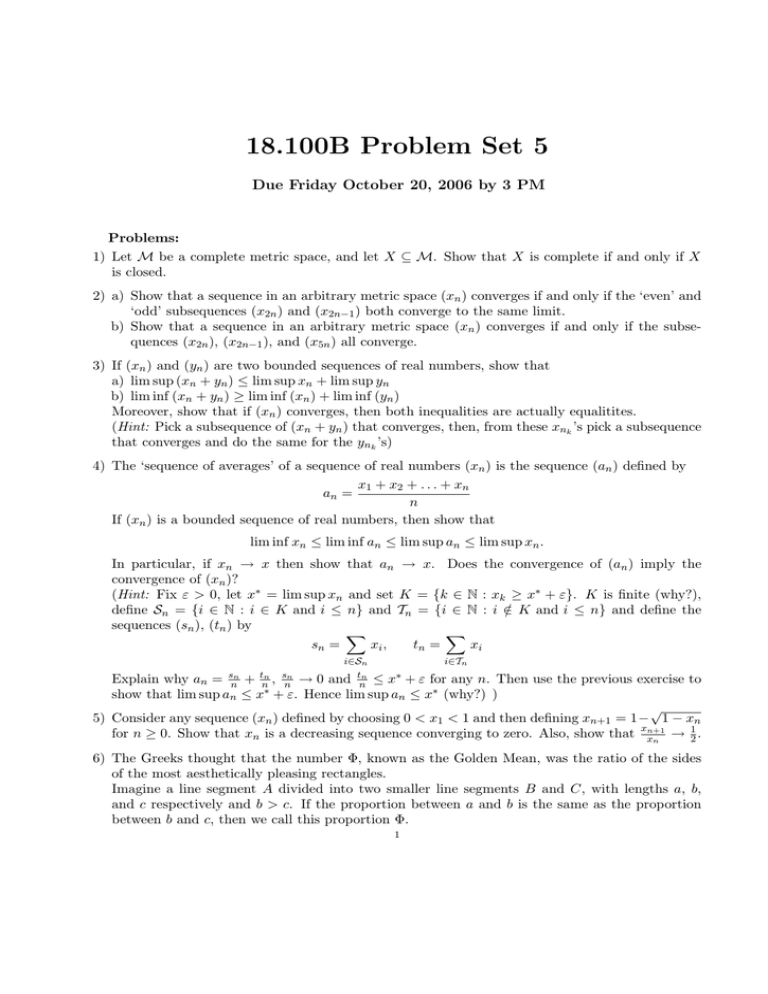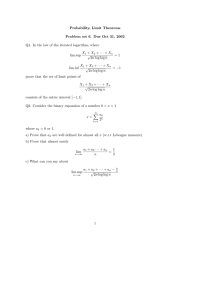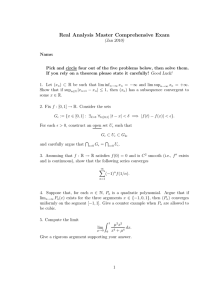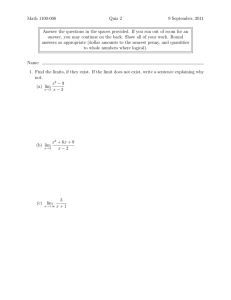Document 13438184
advertisement

18.100B Problem Set 5
Due Friday October 20, 2006 by 3 PM
Problems:
1) Let M be a complete metric space, and let X ⊆ M. Show that X is complete if and only if X
is closed.
2) a) Show that a sequence in an arbitrary metric space (xn ) converges if and only if the ‘even’ and
‘odd’ subsequences (x2n ) and (x2n−1 ) both converge to the same limit.
b) Show that a sequence in an arbitrary metric space (xn ) converges if and only if the subse­
quences (x2n ), (x2n−1 ), and (x5n ) all converge.
3) If (xn ) and (yn ) are two bounded sequences of real numbers, show that
a) lim sup (xn + yn ) ≤ lim sup xn + lim sup yn
b) lim inf (xn + yn ) ≥ lim inf (xn ) + lim inf (yn )
Moreover, show that if (xn ) converges, then both inequalities are actually equalitites.
(Hint: Pick a subsequence of (xn + yn ) that converges, then, from these xnk ’s pick a subsequence
that converges and do the same for the ynk ’s)
4) The ‘sequence of averages’ of a sequence of real numbers (xn ) is the sequence (an ) defined by
x1 + x2 + . . . + xn
an =
n
If (xn ) is a bounded sequence of real numbers, then show that
lim inf xn ≤ lim inf an ≤ lim sup an ≤ lim sup xn .
In particular, if xn → x then show that an → x. Does the convergence of (an ) imply the
convergence of (xn )?
(Hint: Fix ε > 0, let x∗ = lim sup xn and set K = {k ∈ N : xk ≥ x∗ + ε}. K is finite (why?),
define Sn = {i ∈ N : i ∈ K and i ≤ n} and Tn = {i ∈ N : i ∈
/ K and i ≤ n} and define the
sequences (sn ), (tn ) by
�
�
tn =
xi
sn =
xi ,
i∈Tn
i∈Sn
sn
tn sn
tn
∗
Explain why an = n + n , n → 0 and n ≤ x + ε for any n. Then
show that lim sup an ≤ x∗ + ε. Hence lim sup an ≤ x∗ (why?) )
use the previous exercise to
√
5) Consider any sequence (xn ) defined by choosing 0 < x1 < 1 and then defining xn+1 = 1− 1 − xn
for n ≥ 0. Show that xn is a decreasing sequence converging to zero. Also, show that xxn+1
→ 12 .
n
6) The Greeks thought that the number Φ, known as the Golden Mean, was the ratio of the sides
of the most aesthetically pleasing rectangles.
Imagine a line segment A divided into two smaller line segments B and C, with lengths a, b,
and c respectively and b > c. If the proportion between a and b is the same as the proportion
between b and c, then we call this proportion Φ.
1
a) Show that with a, b, and c as above, Φ =
b) Show that:
Φ = 1+
b
c
1+
√
1+ 5
2 .
1
1+
Hint: Define x1 = 1 and xn+1 = 1 + x1n .
c) Show that:
�
�
Φ =
satisfies Φ2 = Φ + 1. Conclude that Φ =
1+
1
1+
1
1
1+ 1+...
�
1+
√
1 + ...
√
Hint: Define y1 = 1 and yn+1 = 1 + yn .
d) The Fibonacci sequence is defined by z1 = 1, z2 = 1, and zn+2 = zn+1 + zn . Show that the
sequence of ratios of succesive elements, zn+1
zn , converges to Φ.
Φ shows up a lot in nature. One reason for this might be that it is the ‘most irrational number’.
For more information about this, check out the links section of the course webpage.
Extra problems:
1) Prove that lim xn = x if and only if every subsequence of (xn ) has a subsequence that
converges to x.
2) If (xn ) is a sequence of strictly positive real numbers, show that
√
√
xn+1
xn+1
lim inf
≤ lim inf n xn ≤ lim sup n xn ≤ lim sup
xn
xn
√
3) Fix a positive number α. Choose x1 > α and define xn for n > 1 by
�
�
1
α
xn +
xn+1 =
2
xn
√
√
Prove that (xn ) decreases monotonically and that lim xn = α. Show that, if εn = xn − α,
then
ε2
ε2
εn+1 = n < √n
2xn
2 α
√
so that, setting β = 2 α,
� �2n
ε1
εn+1 < β
β
MIT OpenCourseWare
http://ocw.mit.edu
18.100B Analysis I
Fall 2010
For information about citing these materials or our Terms of Use, visit: http://ocw.mit.edu/terms.





